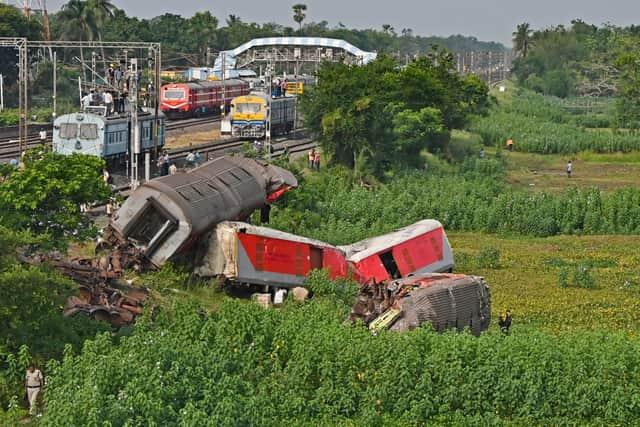India train crash: signal error led to rail crash that killed more than 300, says India minister
and live on Freeview channel 276
The rail crash in eastern India which killed more than 300 people and injured hundreds of others was caused by an error in the electronic signalling system which led to a train wrongly changing tracks, India’s railways minister said on Sunday.
“Who has done it and what is the reason will come out of an investigation,” Ashwini Vaishnaw said in an interview with New Delhi Television network.
Advertisement
Hide AdAdvertisement
Hide AdThe explanation came as authorities worked to clear the mangled wreckage of the two passenger trains that derailed in the Balasore district of eastern Odisha state on Friday (2 June) night, in one of the country’s deadliest rail accidents in decades.
What is the latest?


The Press Trust of India news agency earlier reported that preliminary investigations had revealed that a signal was given to the Coromandel Express to enter the main track line but the signal was later taken off.
The train entered another line, known as the loop line, and crashed into a goods train parked there, PTI said.
Fifteen bodies were recovered on Saturday (3 June) evening and efforts continued overnight as heavy cranes were used to remove an engine that had settled on top of a rail car.
Advertisement
Hide AdAdvertisement
Hide AdNo bodies were found in the engine and the work was completed on Sunday (4 June) morning, said Sudhanshu Sarangi, director-general of fire and emergency services in Odisha.
Hundreds of accident happen each year on India’s railways
The accident happened at a time when Prime Minister Narendra Modi is focusing on the modernisation of the British colonial-era railroad network in India, which has become the world’s most populous country with 1.42 billion people.
Despite government efforts to improve rail safety, several hundred accidents occur every year on India’s railways, the largest train network under one management in the world. Chaotic scenes erupted on Friday night as rescuers climbed on top of the wrecked trains to break open doors and windows using cutting torches to try to save people who were trapped inside the carriages.
Modi went to the crash site on Saturday to see the relief effort and talk to rescue officials. He also visited a hospital, where he asked doctors about the treatments being given to the injured, and spoke to some of the patients.
Advertisement
Hide AdAdvertisement
Hide AdHe told reporters he felt the pain of those who suffered in the accident, and said the government will do its utmost to help them and strictly punish anyone found responsible.
India’s worst rail disaster since the 1990s
Ten to 12 coaches of one train derailed, and debris from some of the mangled coaches fell on to a nearby track. The debris was hit by another passenger train coming from the opposite direction, causing up to three coaches of the second train to also derail, said a rail ministry spokesman.
In 1995, two trains collided near New Delhi, killing 358 people in one of the worst rail accidents in India. In 2016, a passenger train slid off the tracks between the cities of Indore and Patna, killing 146 people.
Most rail accidents in India are blamed on human error or outdated signalling equipment. More than 12 million people take 14,000 trains across India every day, traveling on 40,000 miles (64,000km) of track.
Comment Guidelines
National World encourages reader discussion on our stories. User feedback, insights and back-and-forth exchanges add a rich layer of context to reporting. Please review our Community Guidelines before commenting.